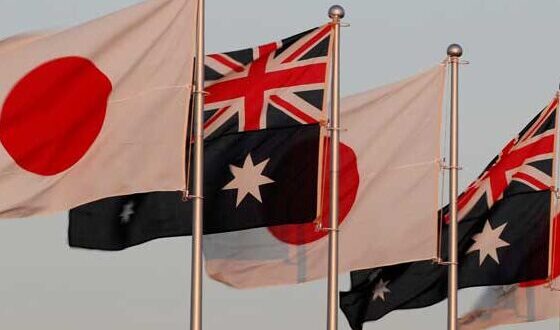Aishwarya Proma
Japan and Australia possess significant importance in terms of their mutual economic and geopolitical interests, therefore establishing themselves as prominent actors within the Indo-Pacific region. Both nations present a mutual dedication to democratic principles, adherence to legal frameworks, and the protection of human rights. Also, Japan and Australia have a significant ability to exert influence on regional matters as well as trade and investment movements. With new goals, both nations have been enhancing strategic and economic connections to reinforce and fortify diplomatic relations.
In light of China’s more assertive conduct over the last decade, Japan and Australia have forged a deeper alliance. Both countries actively engage as players in the ongoing strategic rivalry. The primary basis for this alliance revolves around technological collaboration since the strategic rivalry at hand relies heavily on crucial technologies. Technology has played a vital role in the realm of strategic rivalry since it is responsible for catalyzing unparalleled transformations in economies, security, individual livelihoods, and global relations. So, Japan and Australia want to achieve dominance in these technologies and establish global benchmarks for these crucial domains to secure a significant strategic edge. Japan has achieved significant advancements in technology. Recently, it announced its intention to establish a national endowment fund worth 10 trillion yen ($107 billion) to enhance research and foster innovation within its esteemed institutions.
Over many years, Japan has actively sought strategies to address the growing aggressiveness of Beijing. In contrast, Australia’s focus on China as a single economic solution persisted until about 2017. This approach led to a concentration of market reliance, economic dependence, and heightened vulnerability in terms of security. The pursuit of Japanese whaling was comparatively less challenging than addressing Beijing’s cyberattacks, militarization of the South China Sea, and covert influence on domestic and international institutions. Japan has maintained a prominent position in the Asian region, with its economy ranking as the second-biggest, surpassed only by China. Moreover, Australia’s proficiency in the development of Anti-Submarine Warfare suggests its potential involvement in the geopolitical dynamics of East Asia and the South China Sea. Therefore, both Japan and Australia want to enhance their security partnership and may benefit from being able to address the threat that China poses.
From a strategic standpoint, Japan and Australia have a considerable number of similarities. This alignment is so profound despite the absence of a formal treaty. On October 22, the Prime Ministers of Australia and Japan convened to endorse a revised Joint Declaration on Security Cooperation (JDSC) to enhance their bilateral security collaboration. Both nations have acknowledged the significance of India and backed the revival of the Quad Alliance. The United States withdrawal from the Trans-Pacific Partnership was mitigated by the efforts of our two nations. In both Tokyo and Canberra, there is a shared acknowledgment that our bilateral relationship should include several dimensions, including strategic partnership, economic aspects, and security and defense considerations. Their shared interests, values, and unwavering determination drove the need to maintain the Indo-Pacific region’s freedom, openness, and resilience. Both Australia and Japan are unable to independently confront and effectively respond to economic pressure, cyberattacks, and misinformation efforts. Therefore, a new age of collaboration and alliance is now in progress.
This presents a significant potential for growth in several aspects, including alliances, technology, capacity, deterrence, and the promotion of a more stable and secure global environment for Australia and Japan. The government of Japan has made a firm commitment to significantly boost its allocation of funds towards defense expenditures. However, similar to Australia’s domestic spending, the objective is not to generate instability and escalate a conflict with China. Instead, it aims to enhance deterrent capabilities to prevent war and enhance peace within the region. Australia’s concept of stability does not imply a complete lack of differentiation or competition. The concept entails the act of coexisting with and effectively handling stress rather than disregarding its existence. But with the growth and modernization in the Chinese military, Australia needs to ensure stability rather than completely eradicate disagreements, competitiveness, or low-level conflicts. So, the combination of technological supremacy and strategic partnership between Australia and Japan is often regarded as the most effective approach to deterrence since it leverages both advanced capabilities and collaborative alliances to project power.
In addition, Australia demonstrates notable proficiency in several critical domains that have relevance to the AUKUS collaboration, such as quantum technology and hypersonic capabilities. The magnitude of Beijing’s investment in essential technology for national security has created a significant threat to Japan and Australia. So, the potential for success of AUKUS Pillar 2 aims to expedite the development of crucial capabilities in hypersonic missiles, AI, quantum, and other advanced technologies between these two countries. It might be significantly enhanced by adopting an inclusive approach rather than an exclusive one. Hence, it is imperative to promote the active engagement of Japan, Australia, the United States and other relevant stakeholders in the Indo-Pacific region.
From an economic perspective, it has been observed that the assistance initiatives of Japan and Australia have often aligned with the objectives of the private sector. Both nations have demonstrated a diligent approach in their efforts to address regional challenges and have engaged in cooperative endeavors, including participation in regional and multilateral forums. Both states have maintained open markets and enhanced accessibility to vaccines within the Asian region by improving infrastructure standards, addressing the climate crisis, fostering the advancement of emerging technologies, promoting responsible utilization of outer space, establishing uniform regulations about trade practices such as investment and e-commerce, and enhancing efficiency in supply chain operations. Moreover, Japan’s recent demonstration of leadership in economic security as the host of the G7 serves as a significant model for Australia to emulate in terms of collaborative efforts in addressing rising security concerns. It is imperative that the next G7 chair, Italy, would be encouraged to assume the responsibility and advance an agenda focused on economic security. Additionally, it is advisable to extend invitations to countries such as Australia, South Korea, and India.
Japan and Australia have the potential to assume leadership roles in regional endeavors regarding energy transition, energy security, and decarbonization. Throughout history, Japan has always depended on Australia as a reliable and secure provider of natural resources and energy supplies. Australia is a significant provider of Japan’s primary industrial resources, including iron ore, coking coal, copper, and alumina, accounting for almost two-thirds of the country’s supply. Additionally, Australia fulfills nearly one-third of Japan’s total energy requirements by supplying liquefied natural gas (LNG) and thermal coal. However, Australian firms are well aware of the significance of preserving and improving their reputation for dependability. The ongoing geopolitical tensions between Ukraine and Russia have heightened apprehensions throughout Asia over the reliability of energy supply, the composition of energy sources (including liquefied natural gas, coal, oil, uranium, and renewable energy), and the accessibility of affordable energy.
In conclusion, Japan and Australia navigate a multifaceted alliance related to strategic partnership, defense collaboration, energy provision and expenses, decarbonization efforts, and swift technological progress. Both states are transforming the global economic framework into a dynamic international power landscape. In an era characterized by anticipated ongoing complexities in the United States-China relationship, Australia and Japan are compelled to strategize effective means of exerting influence on regional dynamics to safeguard their interests.
 Geostrategic Media Political Commentary, Analysis, Security, Defense
Geostrategic Media Political Commentary, Analysis, Security, Defense





